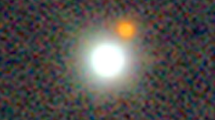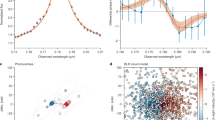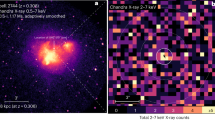Abstract
Recent observations have shown that, only a billion years after the Big Bang, the Universe was already lit up by bright quasars1 fuelled by the infall of gas onto supermassive black holes. The masses of these early black holes are inferred from their luminosities to be >109 solar masses (M⊙), which is a difficult theoretical challenge to explain. Like nearby quasars, the early objects could have formed in the central cores of massive host galaxies. The formation of these hosts could be explained if, like local large galaxies, they were assembled gravitationally inside massive (> 1012 M⊙) haloes of dark matter2. There has hitherto been no observational evidence for the presence of these massive hosts or their surrounding haloes. Here we show that the cosmic gas surrounding each halo must respond to its strong gravitational pull, where absorption by the infalling hydrogen produces a distinct spectral signature. That signature can be seen in recent data3,4.
This is a preview of subscription content, access via your institution
Access options
Subscribe to this journal
Receive 51 print issues and online access
$199.00 per year
only $3.90 per issue
Buy this article
- Purchase on Springer Link
- Instant access to full article PDF
Prices may be subject to local taxes which are calculated during checkout


Similar content being viewed by others
References
Fan, X. et al. Survey of z > 5.8 quasars in the Sloan digital sky survey. I. Discovery of three new quasars and the spatial density of luminous quasars at z ∼ 6. Astron. J. 122, 2833–2849 (2001)
Barkana, R. & Loeb, A. In the beginning: the first sources of light and the reionization of the universe. Phys. Rep. 349, 125–238 (2001)
Zheng, W. et al. Five high-redshift quasars discovered in commissioning imaging data of the Sloan Digital Sky Survey. Astron. J. 120, 1607–1611 (2000)
Becker, R. H. et al. Evidence for reionization at z ∼ 6: Detection of a Gunn-Peterson trough in a z = 6.28 quasar. Astron. J. 122, 2850–2857 (2001)
Loeb, A. & Eisenstein, D. J. Probing early clustering with Lyα absorption lines beyond the quasar redshift. Astrophys. J. 448, 17–26 (1995)
Ferrarese, L. & Merritt, D. A fundamental relation between supermassive black holes and their host galaxies. Astrophys. J. 539, L9–L12 (2000)
Tremaine, S. et al. The slope of the black hole mass versus velocity dispersion correlation. Astrophys. J. 574, 740–753 (2002)
Wyithe, J. S. B., Loeb, A. A physical model for the luminosity function of high-redshift quasars. Astrophys. J. (in the press)
Vanden Berk, D. E. et al. Composite quasar spectra from the Sloan Digital Sky Survey. Astron. J. 122, 549–564 (2001)
Telfer, R. C., Zheng, W., Kriss, G. A. & Davidsen, A. F. The rest-frame extreme-ultraviolet spectral properties of quasi-stellar objects. Astrophys. J. 565, 773–785 (2002)
Yuan, W., Brinkmann, W., Siebert, J. & Voges, W. Broad band energy distribution of ROSAT detected quasars. II. Radio-quiet objects. Astron. Astrophys. 330, 108–122 (1998)
Abel, T. & Haehnelt, M. G. Radiative transfer effects during photoheating of the intergalactic medium. Astrophys. J. 520, L13–L16 (1999)
Fan, X. et al. Evolution of the ionizing background and the epoch of reionization from the spectra of z ∼ 6 quasars. Astron. J. 123, 1247–1257 (2002)
Barkana, R. Did the universe reionize at redshift six? New Astron. 7, 85–100 (2002)
Miralda-Escudé, J. Reionization of the intergalactic medium and the damping wing of the Gunn-Peterson trough. Astrophys. J. 501, 15–22 (1998)
Wyithe, J. S. B. & Loeb, A. Magnification of light from many distant quasars by gravitational lenses. Nature 417, 923–925 (2002)
Gunn, J. E. & Gott, J. R. On the infall of matter into clusters of galaxies and some effects on their evolution. Astrophys. J. 176, 1–19 (1972)
Bertschinger, E. Self-similar secondary infall and accretion in an Einstein–de Sitter universe. Astrophys. J. Suppl. 58, 39–65 (1985)
Keshet, U., Waxman, E., Loeb, A., Springel, V., Hernquist, L. Gamma-rays from intergalactic shocks. Astrophys. J. (in the press)
Abel, T., Bryan, G. L. & Norman, M. L. The formation of the first star in the universe. Science 295, 93–98 (2002)
Scharf, C. A., Mukherjee, R. A statistical detection of gamma-ray emission from galaxy clusters: implications for the gamma-ray background and structure formation. Astrophys. J. 580, 154–163 (2002)
Loeb, A. & Waxman, E. Cosmic γ-ray background from structure formation in the intergalactic medium. Nature 405, 156–158 (2000)
Gunn, J. E. & Peterson, B. A. On the density of neutral hydrogen in intergalactic space. Astrophys. J. 142, 1633–1641 (1965)
Bajtlik, S., Duncan, R. C. & Ostriker, J. P. Quasar ionization of Lyα clouds—the proximity effect, a probe of the ultraviolet background at high redshift. Astrophys. J. 327, 570–583 (1988)
Haiman, Z. The detectability of high-redshift Lyα emission lines prior to the reionization of the universe. Astrophys. J. 576, L1–L4 (2002)
Miralda-Escudé, J., Haehnelt, M. & Rees, M. J. Reionization of the inhomogeneous universe. Astrophys. J. 530, 1–16 (2000)
Loeb, A. & Rybicki, G. B. Scattered Lyman alpha radiation around sources before cosmological reionization. Astrophys. J. 524, 527–535 (1999)
Haiman, Z. & Rees, M. J. Extended Lyman alpha emission around young quasars: A constraint on galaxy formation. Astrophys. J. 556, 87–92 (2001)
Pentericci, L. et al. VLT optical and near-infrared observations of the z = 6.28 quasar SDSS J1030 + 0524. Astron. J. 123, 2151–2158 (2002)
Brotherton, M. S., Wills, B. J., Steidel, C. C. & Sargent, W. L. W. Statistics of QSO broad emission-line profiles. 2: The C IV wavelength 1549, C III wavelength 1909, and MG II wavelength 2798 lines. Astrophys. J. 423, 131–142 (1994)
Acknowledgements
We thank E. Turner and H. Netzer for discussions, and are grateful for the hospitality of the Institute for Advanced Study where this work was completed. R.B. acknowledges the support of an Alon Fellowship at Tel Aviv University and of the Israel Science Foundation. A.L. acknowledges support from the Institute for Advanced Study and a John Simon Guggenheim Memorial Fellowship. This work was also supported by the National Science Foundation.
Author information
Authors and Affiliations
Corresponding authors
Ethics declarations
Competing interests
The authors declare that they have no competing financial interests.
Rights and permissions
About this article
Cite this article
Barkana, R., Loeb, A. Spectral signature of cosmological infall of gas around the first quasars. Nature 421, 341–343 (2003). https://doi.org/10.1038/nature01330
Received:
Accepted:
Issue Date:
DOI: https://doi.org/10.1038/nature01330
This article is cited by
-
Caught in the act?
Nature (2004)
-
The Lyman-α glow of gas falling into the dark matter halo of a z = 3 galaxy
Nature (2004)
-
Dark matter halos found?
Nature (2003)
-
Feeding the first quasars
Nature (2003)
Comments
By submitting a comment you agree to abide by our Terms and Community Guidelines. If you find something abusive or that does not comply with our terms or guidelines please flag it as inappropriate.



